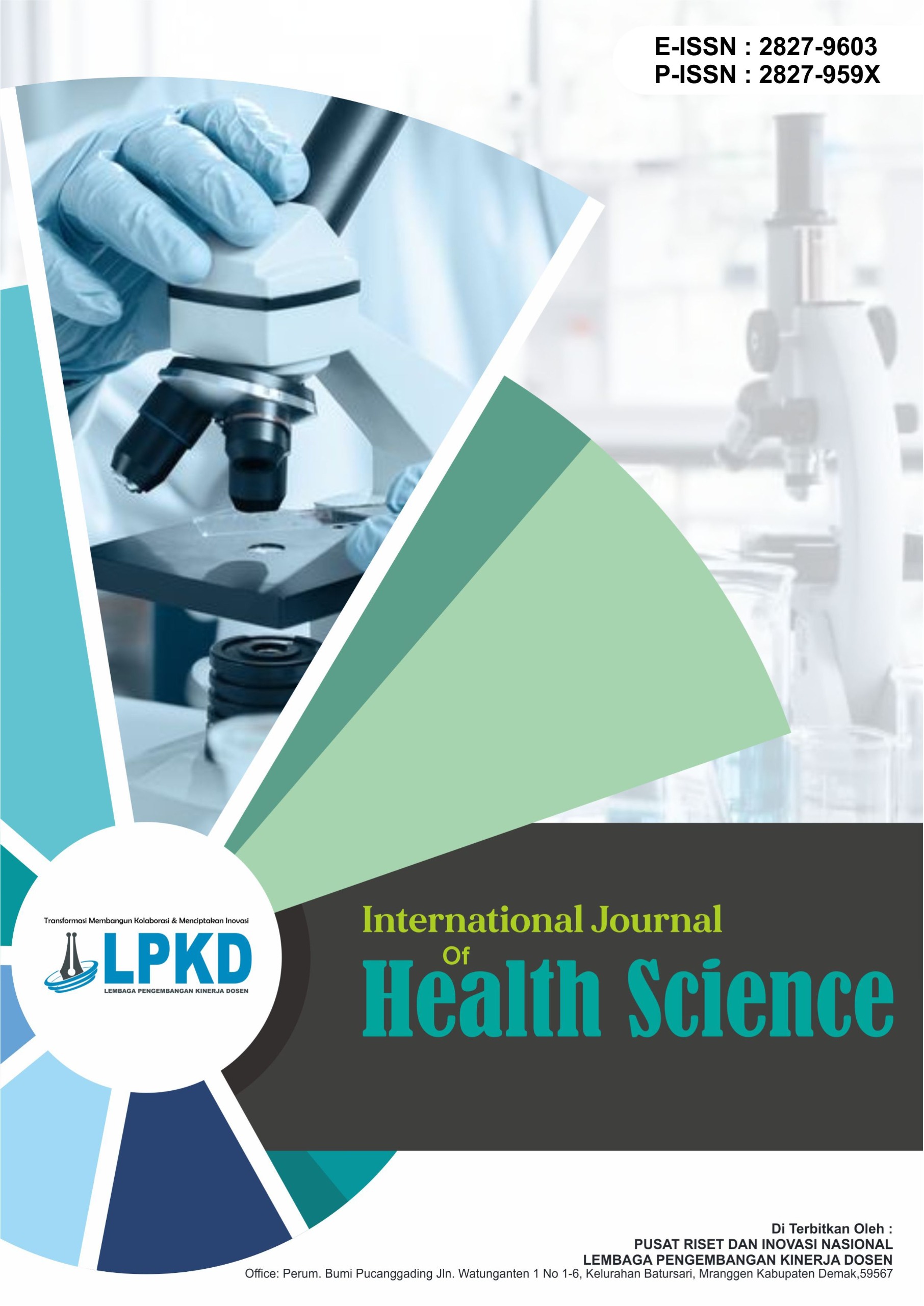A Qualitative Study on Risk Factors Contributing to Stunting in Karang Dima Village, Sumbawa Regency
DOI:
https://doi.org/10.55606/ijhs.v5i2.5648Keywords:
health determinants, Infection, Nutrition, Sanitation, StuntingAbstract
Stunting is a significant public health issue with lasting effects on human development and the quality of the workforce. This study aimed to identify the risk factors of stunting using an epidemiological approach in Karang Dima Village, Sumbawa Regency. A descriptive qualitative method was employed, and data were gathered through in-depth interviews with 22 mothers of stunted children and environmental observations. The results highlighted several key factors contributing to stunting. Host factors, such as low maternal nutritional knowledge, improper parenting practices, and limited spousal support during pregnancy, were identified as primary contributors. These factors negatively influence a mother’s ability to provide adequate care and nutrition during pregnancy and the early stages of a child’s life. Agent factors included recurrent infections, including diarrhea, acute respiratory infections (ARI), and measles. These infections, often linked to weak child immunity, exacerbate the risk of stunting, especially when compounded by poor nutritional intake. Environmental factors also played a significant role. Poor sanitation, high population density, and exposure to pollution from household waste burning and indoor cigarette smoke were noted as critical elements in the village’s stunting risk profile. These environmental conditions compromise both maternal and child health, increasing vulnerability to infections and impairing overall development. The study emphasizes that stunting prevention requires a comprehensive, multi-faceted approach. Nutritional education, improved sanitation, and greater family involvement, particularly from fathers and extended family members, are essential in reducing stunting risk. The findings highlight the need for cross-sectoral strategies to address the various interrelated factors contributing to stunting, particularly in vulnerable communities. Accelerating stunting reduction efforts requires a collaborative, community-driven approach involving healthcare providers, local governments, and families.
Downloads
References
[1] Kemenkes RI, Profil Kesehatan Indonesia Tahun 2015, Jakarta: Departemen Kesehatan Republik Indonesia, 2019.
[2] Kementerian Kesehatan Republik Indonesia, "Prevalensi stunting nasional turun menjadi 19,8 persen pada 2024," 2025. [Online]. Available: https://www.kemkes.go.id/eng/ssgi-2024-prevalensi-stunting-nasional-turun-menjadi-198.
[3] UNICEF Indonesia, "Nutrition: Ending all forms of malnutrition," 2024. [Online]. Available: https://www.unicef.org/indonesia/nutrition.
[4] Kemenkes, "Perbaiki gizi ibu hamil dan balita, Kemenkes dorong penggunaan pangan lokal bergizi," 2025. [Online]. Available: https://www.kemkes.go.id/eng/rilis-kesehatan/perbaiki-gizi-ibu-hamil-dan-balita-kemenkes-dorong-penggunaan-pangan-lokal-bergizi.
[5] AP News, "Indonesia launches free meals program to feed children and pregnant women to fight malnutrition," 2024, March 5. [Online]. Available: https://apnews.com/article/213a04587203434f3f85950725e84a8b.
[6] Sehatnegeriku, "Gerakan Ibu Hamil Sehat untuk turunkan stunting dan angka kematian ibu," 2024, December 13. [Online]. Available: https://sehatnegeriku.kemkes.go.id/baca/rilis-media/20221213/5542001/gerakan-ibu-hamil-sehat-untuk-turunkan-stunting-dan-angka-kematian-ibu.
[7] Kompas, "Angka stunting turun tetapi tidak merata, kompleksnya persoalan gizi di Indonesia," 2025, May 27. [Online]. Available: https://www.kompas.id/artikel/en-angka-stunting-turun-tetapi-tidak-merata-kompleksnya-persoalan-gizi-di-indonesia.
[8] World Health Organization, "Childhood stunting: Context, causes and consequences - A framework," 2022. [Online]. Available: https://www.who.int/publications/m/item/childhood-stunting-context-causes-and-consequences-framework.
[9] World Health Organization, "Healthy beginnings, hopeful futures: How Indonesia's commitment to maternal and child health is changing lives," 2025, April 7. [Online]. Available: https://www.who.int/indonesia/news-room/item/07-04-2025-healthy-beginnings--hopeful-futures--how-indonesia-s-commitment-to-maternal-and-child-health-is-changing-lives.
[10] Antara News, "Indonesia pushes nutrition aid for pregnant women to cut stunting," 2025, July 1. [Online]. Available: https://en.antaranews.com/news/363325/indonesia-pushes-nutrition-aid-for-pregnant-women-to-cut-stunting.
[11] Y. Nurmalisa, "Peranan Pembelajaran Pendidikan Kewarganegaraan Dalam Membangun Civic Conscience," Jurnal Bhineka Tunggal Ika, vol. 7, no. 1, 2021. https://doi.org/10.36706/jbti.v7i1.10082.
[12] K. Phu, J. Wittayasooporn, and C. Kongsaktrakul, "Influence of child feeding practices and selected basic conditioning factors on stunting in children between 6 and 24 months of age in Myanmar," 23(2), 2019. https://doi.org/10.7454/msk.v23i2.10397.
[13] Z. Khorrami, A. Sayarifard, S. Ghahari, N. Memaryan, M. Pirmoradi, and L. Ghadirian, "High school students' depression literacy about interventions and prevention: A survey in Tehran," Depression Research and Treatment, 2023, Article ID 8540614, 1-8. https://doi.org/10.1155/2023/8540614.
[14] F. Ulfah, M. A. Perdana, N. A. N. Istiqomah, N. Hadiqo, and N. R. Ain, "Identifikasi faktor sanitasi lingkungan pada keluarga dengan balita stunting di Desa Keliling Benteng Ulu, Kabupaten Banjar," Lambung Mangkurat Medical Seminar, vol. 3, no. 1, pp. 41-49, 2022. [Online]. Available: https://lummens.ulm.ac.id/ojs3/index.php/proceeding/article/view/6.
[15] F. He, J. Wang, Y. Liu, Y. Zhang, and L. Li, "Indoor air pollution from household solid fuel use and childhood respiratory diseases: A systematic review and meta-analysis," Environmental Pollution, vol. 292, p. 118320, 2022. https://doi.org/10.1016/j.envpol.2021.118320.
[16] K. A. Dearden, B. T. Crookston, A. W. Lehnhoff, S. C. Alder, C. A. Porucznik, J. B. Stanford, and M. E. Penny, "Improving household sanitation and hygiene to reduce stunting: Evidence from a longitudinal study in Peru," BMC Public Health, vol. 21, Article 547, 2021. https://bmcpublichealth.biomedcentral.com/articles/10.1186/s12889-021-10501-9.
[17] W. F. Azrimaidaliza, N. C. Nur, and R. Putri, "Mencegah stunting melalui edukasi gizi seimbang pada ibu hamil dan ibu balita di Puskesmas Lapai," Panrita Abdi: Jurnal Pengabdian pada Masyarakat, vol. 6, no. 4, pp. 934-943, 2022. [Online]. Available: http://journal.unhas.ac.id/index.php/panritaabdi/article/view/14761.
[18] S. M. T. de Oliveira, et al., "Epidemiological study of violence against children and its increase during the COVID-19 pandemic," International Journal of Environmental Research and Public Health, vol. 18, no. 19, p. 10061, 2021. https://doi.org/10.3390/ijerph181910061.
Downloads
Published
How to Cite
Issue
Section
License
Copyright (c) 2025 International Journal Of Health Science

This work is licensed under a Creative Commons Attribution-ShareAlike 4.0 International License.







